AIR ACCIDENT; SOUTH HEIGHTON; MONDAY 3rd JULY 1911. (Revised)
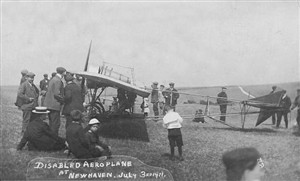
Curious villagers visit the scene. Note Denton Road in the distance; then just a chalk cart track
Contemporary Postcard
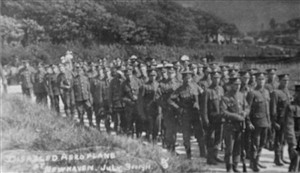
Soldiers arriving from Newhaven Fort
Newhaven Local & Maritime Museum
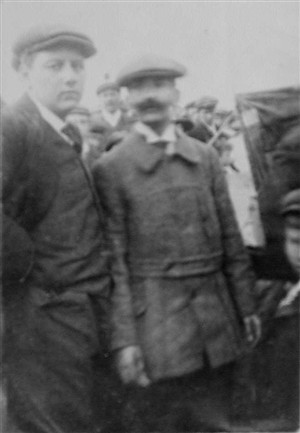
M. Emile Train (centre)
Newhaven Local & Maritime Museum
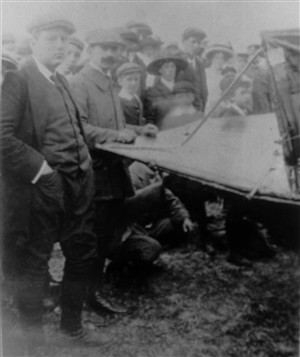
M. Emile Train explains the damage sustained to a group of onlookers.
Newhaven Local & Maritime Museum
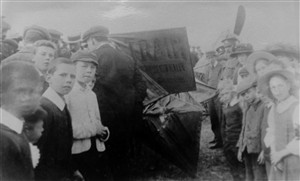
The photographer momentarily commands more interest than the aircraft.
Newhaven Local & Maritime Museum
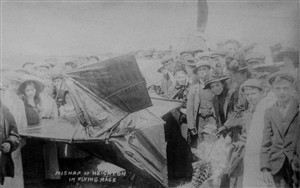
Is this another view of the damaged tailplane or a well-organised photo opportunity?
Newhaven Local & Maritime Museum
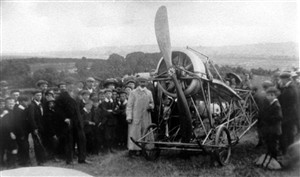
The front wings have been removed, revealing the mainframe and engine. Note the fixed front wheels without brakes. Could this have been taken during the preparations for shipping the damaged craft back to France?
Newhaven Local & Maritime Museum
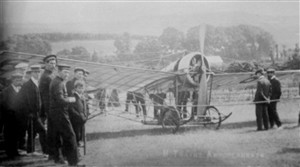
The aircraft is roped off to keep the onlookers at a distance.
Newhaven Local & Maritime Museum
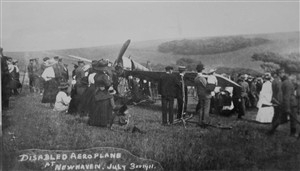
Investigations continue behind the ropes. Note The Plantation in the background
Newhaven Local & Maritime Museum
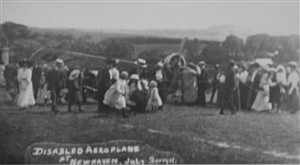
The villagers visit in their best finery.
Newhaven Local & Maritime Museum
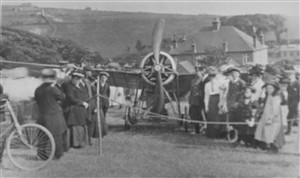
Another afternoon shot. The shadows suggest it is just after mid-day. The house in the background is in Denton Rise on the corner with Rectory Road, to the right of it is the Pumping Station (with the 3 windows) situated in Denton Road next to the "Flying Fish" pub.
Newhaven Local & Maritime Museum
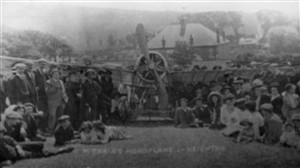
Looks like a curtain call.
Newhaven Local & Maritime Museum
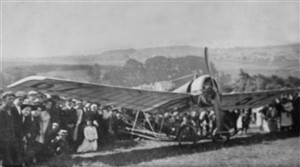
Everybody smile.
Newhaven Local & Maritime Museum
Disaster on the CALAIS - LONDON leg of The Great European Aviation Circuit aeroplane race.
By Geoffrey Ellis
The Times for Tuesday, July 4th 1911 records the unanticipated accident of the previous day that befell luckless M. Emile Train, a participating French aviator, in the closing stages of the CALAIS - LONDON leg of the great aeroplane race known as the European Aviation Circuit organised by the Standard and Le Journal de Paris.
Train, flying an aeroplane of his own invention, apparently became confused in poor visibility, lost his bearings and mistook the River Ouse for the River Adur. He proposed to fly his monoplane aircraft cross the Channel from Calais, follow the English coast to Shoreham, and then turn north for Hendon as the last leg in the race. Unable to locate Shoreham airport, he decided to land to enquire of his location. (Radio beacons and airport radio did not exist back in 1911. Aerial navigation was a matter of the pilot following rivers, roads or railways!). He chose to land in a field between South Heighton and Denton, relying upon the gradient of the hill to stop the aircraft. Unfortunately, without brakes or steering, the aircraft then promptly rolled backwards down the hill, became entangled in a wire fence, and sustained such damage that he was unable to complete the race. He would have feathered his engine during landing or he might possibly have been able to arrest or at least control the unanticipated rollback. His descent was "a very easy one", but the weight of the machine caused it to run backwards down the hill into the wire fence, breaking two of the rudder stays and buckling his rear plane, sustaining such damage that he was unable to complete the race. (The aviator was much distressed about the damage and said he was afraid he would lose the day's flight). In point of fact, he was forced to abandon the race.
News of the incident spread quickly and a platoon of soldiers had to be sent from Newhaven Fort to keep sightseers at a distance whilst the damage was investigated.
M. Emile Train, born 22 October 1877 at St. Etienne (Loire), received his Pilot’s Certificate on 9 August 1910. His aircraft was self-constructed and powered by a 70 HP 7-cylinder GNOME engine making 1200 r.p.m.
An article discovered recently (2014) by local historian Raymond Burchett in the Sussex Express, Surrey Standard and Kent Mail for Friday, July 7, 1911, states that ‘M. Train had his monoplane packed up, and it left for France the same evening’. Whilst The Times for Thursday 6 July 1911, recorded that “Train is still near Newhaven".
Photographs of the incident may be found at Newhaven Local & Maritime Museum, Paradise Park, Avis Road, Newhaven, BN9 0DH. Ask the museum attendant for a computer printed index to the albums containing photographs relating to this incident.
A full account of the race can be found on-line from The Times digital archive. If you are a member of East Sussex Library, and have a membership card and PIN (both available to local residents F.O.C.), you can access The Times, 4th July 1911 CALAIS – LONDON FLIGHT digital archive account on-line, which cannot be reproduced here for copyright reasons.
It would appear that 1911 was not a good year for M. Train, aeronautically speaking.
Only four weeks earlier, M. Train had been involved in a serious aeroplane accident at Issy-les-Moulineaux, France, at the start of the PARIS – MADRID contest, on Sunday, 21 May, 1911, when his aircraft faltered on take-off – neither his engine or rudder was working satisfactorily, and he plunged into a crowd of Ministerial spectators, who had strolled into the middle of the course 'to get a better view', regardless of friendly warnings, killing M. Berteaux, Minister of War, and seriously injuring M. Monis, Prime Minister, in front of a crowd alleged to number “several hundred thousand spectators”.
An article entitled AEROPLANE ACCIDENT IN FRANCE in The Times, 21st May 1911 described in lurid and graphic detail the event and the injuries sustained by the onlookers, running into 4 or 5 columns (7600 words). (Search for “Issy-les-Moulineaux”).
Please note the information given above varies significantly from the original article published on this web site prior to 2014 owing to inadequate and/or flawed information regarding the departure of the luckless pilot and his craft, for which apologies are duly made.